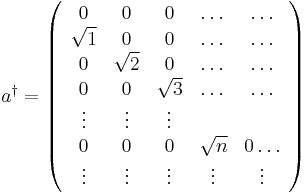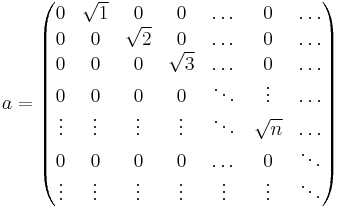Creation and annihilation operators
| Quantum optics operators |
|---|
| Ladder operators |
| Creation and annihilation operators |
| Displacement operator |
| Rotation operator (quantum mechanics) |
| Squeeze operator |
| Anti-symmetric operator |
| Quantum correlator |
| Hanbury Brown and Twiss effect |
| [edit this template] |
Creation and annihilation operators are mathematical operators that have widespread applications in quantum mechanics, notably in the study of quantum harmonic oscillators and many-particle systems.[1] An annihilation operator lowers the number of particles in a given state by one. A creation operator increases the number of particles in a given state by one, and it is the adjoint of the annihilation operator. In many subfields of physics and chemistry, the use of these operators instead of wavefunctions is known as second quantization.
Creation and annihilation operators can act on states of various types of particles. For example, in quantum chemistry and many-body theory the creation and annihilation operators often act on electron states. They can also refer specifically to the ladder operators for the quantum harmonic oscillator. In the latter case, the raising operator is interpreted as a creation operator, adding a quantum of energy to the oscillator system (similarly for the lowering operator). They can be used to represent phonons.
The mathematics for the creation and annihilation operators for bosons is the same as for the ladder operators of the quantum harmonic oscillator.[2] For example, the commutator of the creation and annihilation operators that are associated with the same boson state equals one, while all other commutators vanish. However, for fermions the mathematics is different, involving anticommutators instead of commutators.[3]
Contents |
Derivation for quantum harmonic oscillator
In the context of the quantum harmonic oscillator, we reinterpret the ladder operators as creation and annihilation operators, adding or subtracting fixed quanta of energy to the oscillator system. Creation/annihilation operators are different for bosons (integer spin) and fermions (half-integer spin). This is because their wavefunctions have different symmetry properties.
For now let's just consider the case of the phonons of the quantum harmonic oscillator, which are bosons, because fermions are more complicated.
Start with the Schrödinger equation for the one dimensional time independent quantum harmonic oscillator
Make a coordinate substitution to nondimensionalize the differential equation
 .
.
and the Schrödinger equation for the oscillator becomes
 .
.
Notice that the quantity  is the same energy as that found for light quanta and that the parenthesis in the Hamiltonian can be written as
is the same energy as that found for light quanta and that the parenthesis in the Hamiltonian can be written as
The last two terms can be simplified by considering their effect on an arbitrary differentiable function f(q),
which implies,
Therefore
and the Schrödinger equation for the oscillator becomes, with substitution of the above and rearrangement of the factor of 1/2,
![\hbar \omega \left[\frac{1}{\sqrt{2}} \left(-\frac{d}{dq}%2Bq \right)\frac{1}{\sqrt{2}} \left(\frac{d}{dq}%2B q \right) %2B \frac{1}{2} \right] \psi(q) = E \psi(q)](/2012-wikipedia_en_all_nopic_01_2012/I/0eee34d320de4253a7553494db23a1c7.png) .
.
If we define
 as the "creation operator" or the "raising operator" and
as the "creation operator" or the "raising operator" and as the "annihilation operator" or the "lowering operator"
as the "annihilation operator" or the "lowering operator"
then the Schrödinger equation for the oscillator becomes
This is significantly simpler than the original form. Further simplifications of this equation enables one to derive all the properties listed above thus far.
Letting  , where "p" is the nondimensionalized momentum operator then we have
, where "p" is the nondimensionalized momentum operator then we have
and

 .
.
Note that these imply that
Applications
The ground state  of the quantum harmonic oscillator can be found by imposing the condition that
of the quantum harmonic oscillator can be found by imposing the condition that
 .
.
Written out as a differential equation, the wavefunction satisfies
which has the solution
The normalization constant C can be found to be ![1\over \sqrt[4]{\pi}](/2012-wikipedia_en_all_nopic_01_2012/I/b8c1448fe6facd13e7a5636ef5e382ca.png) from
from  , using the Gaussian integral.
, using the Gaussian integral.
Matrix representation
The matrix counterparts of the creation and annihilation operators obtained from the quantum harmonic oscillator model are
Substituting backwards, the laddering operators are recovered. They can be obtained via the relationships  and
and  . The wavefunctions are those of the quantum harmonic oscillator, and are sometimes called the "number basis".
. The wavefunctions are those of the quantum harmonic oscillator, and are sometimes called the "number basis".
Mathematical details
The operators derived above are actually a specific instance of a more generalized class of creation and annihilation operators. The more abstract form of the operators satisfy the properties below.
Let H be the one-particle Hilbert space. To get the bosonic CCR algebra, look at the algebra generated by a(f) for any f in H. The operator a(f) is called an annihilation operator and the map a(.) is antilinear. Its adjoint is a†(f) which is linear in H.
For a boson,
![[a(f),a(g)]=[a^\dagger(f),a^\dagger(g)]=0](/2012-wikipedia_en_all_nopic_01_2012/I/d3645ff1e4162d8359fabe178a3f9591.png)
![[a(f),a^\dagger(g)]=\langle f|g \rangle](/2012-wikipedia_en_all_nopic_01_2012/I/cd31c881409728d5ca54035b62981642.png) ,
,
where we are using bra-ket notation.
For a fermion, the anticommutators are

 .
.
A CAR algebra.
Physically speaking, a(f) removes (i.e. annihilates) a particle in the state | f  whereas a†(f) creates a particle in the state | f
whereas a†(f) creates a particle in the state | f  .
.
The free field vacuum state is the state with no particles. In other words,
where | 0  is the vacuum state.
is the vacuum state.
If | f  is normalized so that
is normalized so that  f | f
f | f  = 1, then a†(f) a(f) gives the number of particles in the state | f
= 1, then a†(f) a(f) gives the number of particles in the state | f  .
.
Creation and annihilation operators for reaction diffusion equations
The annihilation and creation operator description has also been useful to analyze classical reaction diffusion equations, such as the situation when a gas of molecules A diffuse and interact on contact, forming an inert product: A + A → ∅ . To see how this kind of reaction can be described by the annihilation and creation operator formalism, consider  particles at a site
particles at a site  on a 1-d lattice. Each particle diffuses independently, so that the probability that one of them leaves the site for short times
on a 1-d lattice. Each particle diffuses independently, so that the probability that one of them leaves the site for short times  is proportional to
is proportional to  , say
, say  to hop left and
to hop left and  to hop right. All
to hop right. All  particles will stay put with a probability
particles will stay put with a probability  .
.
We can now describe the occupation of particles on the lattice as a `ket' of the form | n1, n2, ...  . A slight modification of the annihilation and creation operators is needed so that
. A slight modification of the annihilation and creation operators is needed so that
and
 .
.
This modification preserves the commutation relation
![[a,a^{\dagger}]=1](/2012-wikipedia_en_all_nopic_01_2012/I/e4cf4de002b962b3e52853653e35d6a3.png) ,
,
but allows us to write the pure diffusive behaviour of the particles as
The reaction term can be deduced by noting that  particles can interact in
particles can interact in  different ways, so that the probability that a pair annihilates is
different ways, so that the probability that a pair annihilates is  and the probability that no pair annihilates is
and the probability that no pair annihilates is  leaving us with a term
leaving us with a term
yielding
Other kinds of interactions can be included in a similar manner.
This kind of notation allows the use of quantum field theoretic techniques to be used in the analysis of reaction diffusion systems.
See also
- Bogoliubov transformations - arises in the theory of quantum optics.
- Optical Phase Space
- Fock space
- Canonical commutation relations
References
- Feynman, Richard P. (1998) [1972]. Statistical Mechanics: A Set of Lectures (2nd ed.). Reading, Massachusetts: Addison-Wesley. ISBN 978-0201360769. http://books.google.com/books?id=Ou4ltPYiXPgC&pg=Front.
Footnotes
- ^ (Feynman 1998, p. 151)
- ^ (Feynman 1998, p. 167)
- ^ (Feynman 1998, pp. 174–5)






![[q, p] = i \,](/2012-wikipedia_en_all_nopic_01_2012/I/432e44d97047244a5c674cfa608c8fee.png)
![[a, a^\dagger ] = \frac{1}{2} [ q %2B ip , q-i p] = \frac{1}{2} ([q,-ip] %2B [ip, q]) = \frac{-i}{2} ([q, p] %2B [q, p]) = 1](/2012-wikipedia_en_all_nopic_01_2012/I/d325a9e4a14331ac14022332ca1c3fc2.png)








